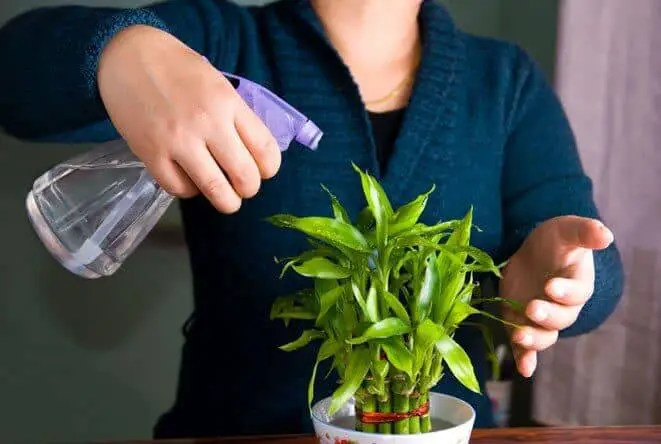The subject of misting indoor plants has surprisingly led to debate. Who knew plant misting was so controversial? Indoor plants require a lot of care, and part of that care may include misting. If not, they will begin to wilt and turn brown just like outdoor plants do when they lack water.
Should indoor plants be misted? Although answers vary on this topic,misting is generally good for indoor plants as long as proper technique is used. Not all plants thrive when misted. Plants with fuzzy leaves, succulents, and spider plants are some of those that should not be misted.
Misting not only will add needed humidity to indoor plants, but it also cleans the plant. If a plant simply needs dust removed, misting is good. Sometimes indoor plants will have bugs on them, and misting rids the plant of the unwanted pests. The following are techniques and facts you need to know about misting indoor plants.
Some Disadvantages to Misting
Misting will help your plant thrive, but there are a few disadvantages if misting is not done properly and in moderation.
Fungal spores have been known to germinate on foliage if misting is overdone. Misting plants in homes with poor air circulation causes bacteria to grow and multiply on your plant. You can help limit this problem by ensuring that air circulates around your plant and that you don’t over mist it.
Misting from Below Rather Than Above
Many horticulturalists believe that misting from above the plant is most beneficial. However, research and case studies indicate that misting from below the plant might be better. Misting from below causes the moisture to settle in soil. The moisture is taken to the roots of the plant where it is needed most.
Other plant experts argue that misting an indoor plant is not at all necessary because indoor humidity should be comfortable. The fact is that the indoor humidity level could be comfortable for people and animals yet not be appropriate for a plant. Indoor misting is usually necessary, and a combination of misting from below and above may be most beneficial.
Mist When Plant Leaves Are Brown
If the leaf tips of your indoor plants are brown, your air in your home is too dry for the plant. Misting is necessary at this point. In this case, watering the plant can cause the roots to become too wet, which leads to other issues.
Light misting is the remedy you are looking for. Some experts have even suggested using a humidifier. If you decide to use a humidifier, do not overdo it. Too much moisture can cause other unhealthy issues.
Misting is Plant TLC
Scientists from Australia conducted research to see if a popular plant lover’s theory bore any truth. People who adore their plants often vow that plants are sensitive to touch. The “touch” they refer to is not only physical touch with human hands but also misting.
Olivier Van Aken from the University of Western Australia determined through research that plants do sense and even thrive from misting and other forms of care. He made it clear that plants do not have a mind in human terms, but they do sense what is going on in their surroundings.
Misting for Ferns and Pothos
Ferns and Pothos can do without regular watering if they are given a good misting daily. These two plants should be away from vents and fans to prevent them from drying out.
The best plant to keep indoors is a fern. It will thrive indoors if properly cared for. Because ferns thrive on moist soil, the soil should not become dried out between mistings.
Mist in Moderation
Although daily misting is good, too much moisture can cause a plant to become susceptible to bacterial and fungal infections. Think about it. Human feet can have fungus if too much moisture. Our bodies also get bacterial infections from certain imbalances.
You can have too much of a good thing, even misting for plants. Some plants do not require a daily misting. Simply monitor the soil and leaves. If the plants and soil are overly dry, mist them. If they seem to have sufficient moisture, wait until later.
What About Misting during the Winter?
While winter air is often dry, plant growth tends to slow down at this time of the year. Some plants will even go dormant. Too much misting or watering could cause the roots to rot. When you do water your plants during winter, make sure the water is room temperature.
If you are uncertain about too much moisture or dryness, simply put your finger one inch into the soil. If the soil is dry, try misting from below. If the soil is moist, wait until it is dry before watering or misting. Once again, you do not want to roots of your plant to rot.
Misting Frequency
Some houseplants will need to be misted one to three times per day. Others will not need to such constant attention. What time of climate the plant originated from will be the key to knowing how often misting is needed.
Many thick-leafed plants do better with dryer soil between watering because of their original climate. Know your plant’s history. Knowing this will keep you from overwatering or underwatering. Both extremes can kill your plant.
Signs of Underwatering
- Brown or yellow leaf edges
- Curled leaf edges
- Leaves grow slowly
- Translucent leaves
Signs of Overwatering
- Leaves with rotten patches
- Mold or fungus on the soil
- Young and old leaves falling off together
- Soggy roots
Which Plants Require More or Less Misting
Some plants will need more water than others, especially if they originated I wet areas. Other plants came from drier areas so they will not need to be misted as frequently.
Plants that Need Less Water
- Plants that have thick or rubbery leaves
- Plants that come from a water retentive mix
- Plants that stay in a cool room
- Plants that have recently been repotted
- Resting plants
- Dormant plants
Plants that Need More Water
- Plants that come from a wet area
- Plants with thin leaves
- Plants that are in small pots
- Plants that are in clay pots
- Plants that grow actively
Water Quality and Temperature
Most indoor plants can be misted in room temperature water. Softened water may contain sodium and should not be overly used on your plant. If you don’t live in a region with acid rain, melted snow is good for house plants.
Plants that come from a tropical climate might do better with water warmer than room temperature. Of course, there are plants that come from cooler climates so the water temperature could be cooler for them. Once again, know your plant’s origin.
Plants that Thrive on Moisture
There are some plants that love extra moisture. Here are the plants that can use it.
- Orchids
- Palms
- African violets
- Corn plants
- Arrowhead plants
- Philodendrons
- Schefflera
- Zebra plants
- Fittonia
Plants that Should Not Be Misted
In most cases, misting is good for plants; however, there are some plants that should not be misted.
- Piggyback plants
- Plants with fuzzy leaves
- Succulents
- Dragontrees
- Fiddle leaf figs
- Ponytail plants
- Spider plants
- Cissus
- Yucca
Alternatives to Misting
If you are still apprehensive about misting, there are other ways that you can go about getting extra moisture to your indoor plants:
- Using a humidifier (wisely, of course) can increase moisture without misting.
- If you place plants on trays containing pebbles and water will provide extra moisture.
- Placing plants close to each other will ensure that they receive extra moisture.
The Bottom Line
Although a matter of some debate, misting is necessary and good for most plants. Using various methods of misting such as from below rather than from above and even using alternative methods will ensure that your plant has the tender loving care it needs.
Just remember that some plants require more moisture than others. Knowing the environment from which your plant come is necessary to provide it with a good indoor environment. Plants are like people. Each one is different and requires different care. That care could be frequent, infrequent, or no misting.



Subscribe To Our Newsletter
Join our mailing list to receive news and updates. Don't worry. We will not smap you ;)
You have Successfully Subscribed!